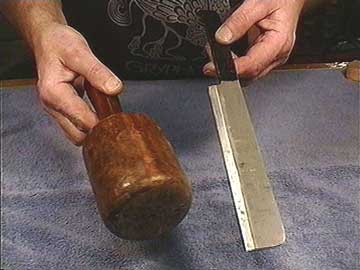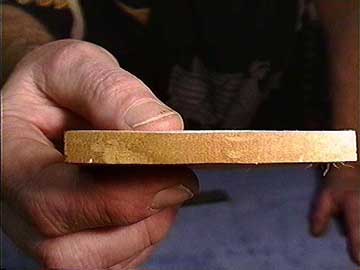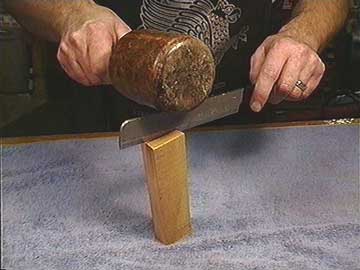FRETS.COM
Illustrated Glossary
This one's only a little bit tricky
Grain Runout
© Frank Ford, 2/17/99; Photos by FF
We all know that the grain of wood runs along the length of the tree trunk or branch.
When a log is cut into rectangular dimension, the grain may or may not run straight
through the length of the piece. If the grain tends to run off the edge, it's called
"runout."
The tricky part is that sometimes it's not all that easy to see in a piece of lumber,
and the grain may run perpendicular to one face, and have a lot of runout in a perpendicular
face of the same piece of wood.
Here's a piece of spruce:

It's easy to see how the grain runs in this dimension. It's quite straight and true,
just like an ideal instrument top.
Here's the end of the same piece:

This is what is called "vertical grain." You can see from this cut end
that the grain lines are almost straight up and down in relation to the flat face
of the board. There's no question how this wood will split if I break it between
these grain lines. It will split directly from one end to another right along the
grain.
Let me take a quick break to introduce you to two simple tools:

The long knife is a Japanese bamboo splitting tool. It's very thick and quite sharp,
and it's the perfect thing for splitting small billets of wood. The other tool is,
of course, my heavy wood carver's mallet.
Now here's the remaining side edge of that spruce board:

You can't really tell the grain direction along this face, even if you look really
closely.
Let me give it a whack:

Now, it's really easy to see the grain direction:

No runout at all! The grain in this piece runs parallel to the face and the piece
splits neatly into two flat pieces of uniform thickness.
This is, by the way, how the very finest instrument wood is cut. To make absolutely
sure that there's no grain runout, the tops of instruments are sometimes cut from
"split billets" to ensure straight, uniform grain with no runout.
Let me split this other piece, which also has the grain running perfectly vertical
along the face and through the length:

Whoops! Clear runout here:

I couldn't tell that there was grain runout by looking at the edges, but splitting
it was a dead giveaway.
Here's a classic case of runout on a finished guitar top.
Notice how the top appears darker on the treble side:

That's because with the light at this angle, we're looking "into" the end
grains (just a little) on the treble side, and we're seeing a light reflection from
the face of the grains on the bass side.
If I turn the guitar upside down, keeping the angle of the light the same, the light
and dark sides reverse:

Now the bass side appears dark, for exactly the same reason the treble side did in
the picture above.
OK, why all the fuss about grain runout?
Well, for one thing, wood with no runout is stronger. If it is really stressed hard
it won't break as easily because the grain can't split off the edge. Severe grain
runout is bound to have an effect on the vibrational characteristics of a top as
well as an effect on the strength. I don't pretend to be able to discuss the theoretical
differences in tone, but in a few cases I've actually seen tops fail structurally
because of grain runout. In those few instruments, the grain runout was astoundingly
bad, say around 30 degrees off parallel.
The guitar pictured above happens to sound GREAT, and shows absolutely no structural
difficulties despite its 29 years under string tension.
The matter of grain runout is largely a cosmetic one, and most builders try to avoid
runout if possible.
Back to Glossary
Back to Index Page









